Rose grafting on rose hips - all about the procedure
Planting a rose on a rosehip is not at all difficult and even a novice gardener can do it. We will consider the features of the vaccination process in more detail later in the article.
Content:
- Rose growing methods
- Types of roses for grafting
- Growing a porker
- Preparation for budding
- Conducting budding
- Eyepiece care
Rose growing methods
Roses are grown by cuttings and grafting. Rooted roses grow from cuttings. They do not form wild root shoots, but they release replacement shoots after the death of the main plant.
The properties of the mother plant of modern roses are not transmitted through the seeds, because they are all hybrids. As a result, different species of rose hips grow from seedlings. They can be used for vaccinations.
But cuttings of many beautiful varieties take root very poorly, some of them die in winter from frost. Such roses are less resistant to disease, grow worse. Therefore, it makes sense to plant them on strong, vigorous rootstocks.
There are two ways to get vaccinated:
- Graft
- Budding
Sometimes, to create standard rose bushes, buds of a cultivar are grafted onto the stem of a rose hip. In order to get a low standard bush, it is cut off at a height of 80 cm, the middle one - at a height of 1 m 20 cm. To create tall bushes, the stem of the dog rose is cut off at a height of one and a half meters. All lower branches and young growth are removed.
Not all wild-growing varieties are used as a stock. They should be:
- Long lasting.
- Do not let a lot of root growth.
- Have a deep root system.
Most often, rosehip is used as a stock (canina rose). It has an even and smooth root collar, from which the bark can be easily separated. The species is frost-resistant, the amount of growth is moderate. Rosehip grows quickly, is resistant to diseases and pests. In addition, it is compatible with most types of roses.
Types of roses for grafting
Roses of the following types are most often propagated by the grafting method:
| Types of roses | Features of the | Varieties |
| Hybrid tea | They are distinguished by large beautiful single flowers. They are resistant to diseases and pests, but can freeze slightly in winter. | Julias Rose, Peace |
| Floribunda | Their flowers are collected in bouquets. There are curb bushes, medium height and high. | Margaret Merrill, Rumba, Epicot Clementine, Angela, Queen Elizabeth |
| Grandiflora | They are similar to tea plants, but have a long flowering period and high frost resistance. | Tchaikovsky, Love |
| Shrubs | Semi-twisted roses. They are used for vertical gardening or as ground cover plants. | Cuthbert Grant, Sommer Morgen |
| Polyanthus | They are distinguished by small flowers collected in shields. | Orange Triumph, The Fairy, Little White Pet |
Growing a porker
Rosehip seeds are harvested in early autumn on bushes, which are easy to find both in the forest and in the city. They take the largest fruits, carefully select the seeds. There are many small spiky needles inside. Beware of getting them in your eyes. The seeds are sown in the fall, immediately after they are taken out of the fruit. This will allow you to get seedlings in the spring.
If the seeds are harvested late, they need to be stratified... The collected seeds are mixed with wet sand, treated from fungi. Placed in a cellar or refrigerator and kept until October next year. In October, they are sown to a depth of 5 cm.This will allow you to get plants with a long root collar, it will be easier to budding on them.
The seeds will sprout in May. After 2 weeks, they are seated (dived) at a distance of 10 cm from each other. In the process of transplanting, pinch their top by a third of the height. This will make it possible to form a strong root system. Seedlings are regularly watered, preventing the soil from drying out. Once a month, they are fed with organic or mineral fertilizers. Good results are obtained by introducing potassium permanganate. It strengthens plants, makes them resistant to fungal diseases.
In autumn, seedlings are mulched with a layer of humus 6 cm high.
It will protect from frost in winter and from drying out of the soil in spring. At the same time, the mulch layer will serve as a source of nutrients. In the spring, they loosen the soil around the seedlings, carry out top dressing. In the middle of summer, most of them are ready for budding. A suitable seedling should have an even, smooth root collar, at least 4 mm thick.
Some specimens by this time are gaining a thickness of 8 mm. Such seedlings are not inoculated, but are left for grafting with a cuttings. At the end of autumn, they are dug out of the garden bed, hidden in a trench in a cellar or a cold basement. The grafting is carried out in the same way as for garden trees.
Preparation for budding
The result of the operation performed largely depends on the correct timing of its implementation. The budding of plants in the ground is carried out during the summer sap flow. It lasts from mid-July to September, although it can be adjusted depending on climatic conditions.
First, hybrid tea roses are inoculated. Their eyes do not germinate in the fall in most cases. Roses of the floribunda group will be oozed later so that they do not have time to bloom by winter. The rootstocks are prepared for the operation 2 weeks in advance. They are watered and hilled. This contributes to the fact that the cambium is soft, the bark is easily separated.
If there are extra shoots near the main trunk, remove them.
Cuttings are harvested, from which the kidneys will be taken. They are cut from the middle parts of the shoots of the varieties that are going to be pinned. Do not take annual shoots that have not yet bloomed. Cuttings are cut in the morning, on the day of budding. If you had to prepare in advance, then store them in the refrigerator in a sealed bag.
Cut off the main part of the leaf, leaving only part of the cutting. It will be possible to hold on to it during the operation. For the operation, you need a special eyepiece knife. It is distinguished by a rounded blade and a special protrusion on the handle for expanding the bark. The knife must be clean and sharp.
Conducting budding
Budding consists of the following stages:
- Remove the soil around the clothespin, freeing the root collar.
- Rub the neck until the bark lightens.
- A T-shaped incision is made. To do this, make a cross cut with a knife with a length of 1/3 of the circle. A longitudinal incision is made with a length of 1.5 ... 2 cm.
- Move the bark away from the wood, then press it back so that the cambium does not oxidize. You can notice this by changing its color.
- A kidney with a thin shield is cut off. To perform the operation successfully, you can first cut the stalk into 2 cm pieces, each with a kidney in the center. Then the pieces are set vertically, holding by part of the handle, and the movement is performed with a knife or blade from top to bottom.
- The thin piece of wood that has ended up on the shield can be removed. The result is a flap 2 cm long. The width is 12 mm at the bottom and 8 mm at the top.
- They hold the flap with one hand, with the other push apart the walls of the T-shaped incision. The flap is quickly inserted into the incision. They are pressed against the wood. If the excess part of the flap remains at the top, cut it off, adjusting it to the shape of the T-shaped cut.
- Tied with pre-prepared materials. It can be electrical tape, plastic strips, compress tape. After the procedure, only a peephole remains on the surface. Fix the end of the tape by tightening the last turn.
- Carefully spud the grafted plant with damp earth. This is to keep moisture in the kidney.
After 2-3 weeks, the survival rate is checked. A successful result is indicated by the enlargement of the bud in size and the fact that the stalk falls off easily when trying to separate it from the trunk. If the operation is unsuccessful, you can repeat it in the spring. This is called bud grafting.
Eyepiece care
At the end of autumn, the grafted bushes are dug up and hidden in a trench. You can leave them in place, having previously hilled them to a height of 25 cm and covered with dry materials. In the spring, they take out the bushes from the ditch, remove the harness. Cut off the upper part with a pruning shears half a centimeter higher above the kidney "on a thorn". The cut site is treated with garden varnish. Planted for growing.
Bushes that have wintered in the garden open up with the onset of warm days. The same procedures are carried out: remove the bandage, cut it on a thorn, cover it with pitch. They sprinkle with loose earth. After 2-3 weeks, the bud germinates. To form the crown correctly, tear off the top of the clothespin after 4 sheets. Sometimes dormant buds can grow. Then several shoots will appear.
You can learn more about grafting roses from the video:
After a while, shoots will grow from the sinuses of the remaining buds, which will then become the main skeletal branches of the new bush. All summer long they loosen the soil around young plants, remove weeds, and water. They are fed with organic and mineral fertilizers for roses. They are treated with protective drugs against fungal diseases. They destroy caterpillars and aphids, which can destroy young plants.
Particular attention should be paid to the removal of the wild cavity.
It differs from cultivated ones in that it has small light green leaves. These shoots are very aggressive, they quickly drown out the grafted ones. Therefore, they should not be allowed to develop and grow.
In early August, young plants should have flower buds. It is recommended to leave some of them on strong shoots. This will allow you to enjoy the new variety and will contribute to better ripening of the shoots.
By autumn, young bushes will have 3-5 main shoots. The buds in their lower part are large, well-ripened. Such a bush will easily endure the winter, and next year they will delight with abundant flowering.






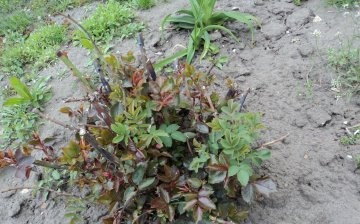
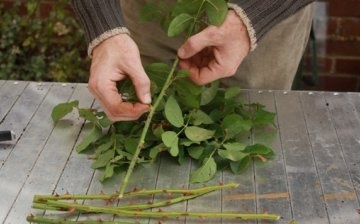
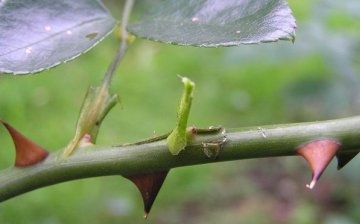








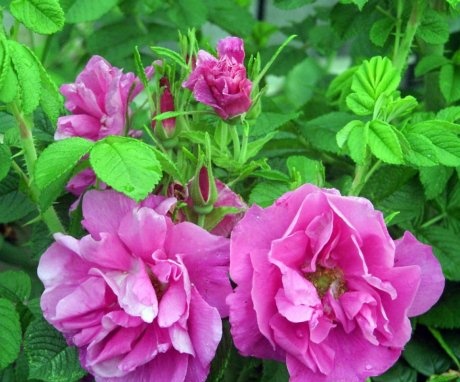
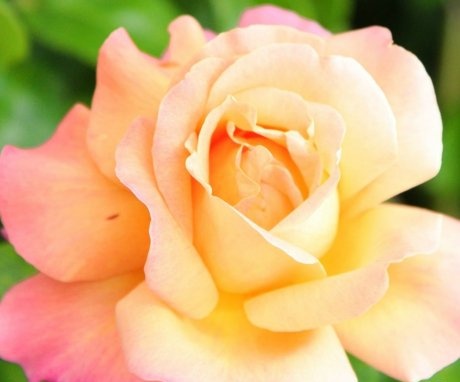
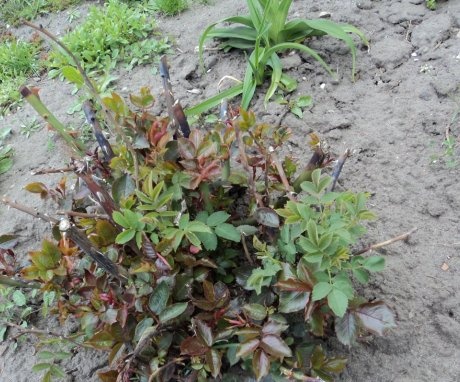
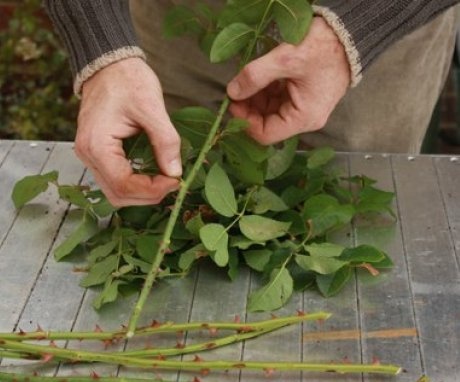
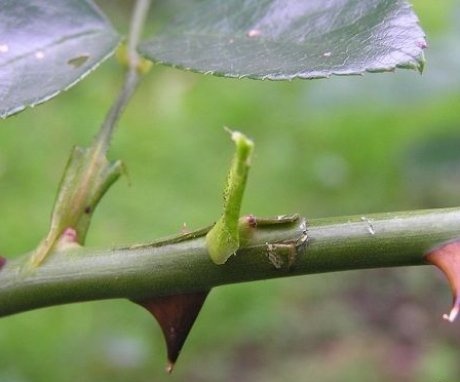

First, you need to plant a dog rose so that it takes root, and then a cultured bud is grafted onto it, that is, budding is done. The rose hips, which are located above the bud, must be cut off. A rose grafted onto a rose hip will have high frost resistance.
Several times I tried to plant a rose on a rosehip, only one attempt was successful, although it seemed to act according to all the rules. For some reason, I'm better at growing roses from cuttings.